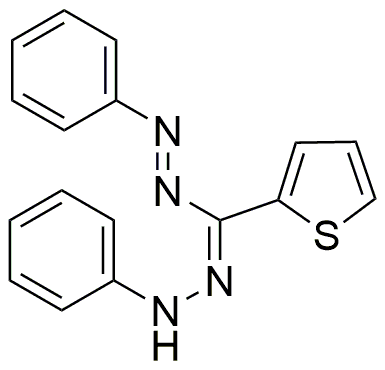1,5-Diphenyl-3-(2-thienyl)formazan is widely utilized in research focused on:
- Analytical Chemistry: This compound serves as a colorimetric reagent for the detection of metal ions, providing a simple and effective method for quantifying trace elements in various samples.
- Organic Synthesis: It acts as a versatile intermediate in the synthesis of other organic compounds, facilitating the development of new materials and pharmaceuticals.
- Biological Research: The compound has shown potential in studying biological processes due to its ability to interact with specific biomolecules, making it useful in drug discovery and development.
- Photovoltaic Applications: Its unique electronic properties make it suitable for use in organic solar cells, contributing to advancements in renewable energy technologies.
- Colorimetric Sensors: The compound can be incorporated into sensor devices for environmental monitoring, allowing for the detection of pollutants and enhancing safety in industrial settings.
Información general
Propiedades
Seguridad y normativas
Aplicaciones
1,5-Diphenyl-3-(2-thienyl)formazan is widely utilized in research focused on:
- Analytical Chemistry: This compound serves as a colorimetric reagent for the detection of metal ions, providing a simple and effective method for quantifying trace elements in various samples.
- Organic Synthesis: It acts as a versatile intermediate in the synthesis of other organic compounds, facilitating the development of new materials and pharmaceuticals.
- Biological Research: The compound has shown potential in studying biological processes due to its ability to interact with specific biomolecules, making it useful in drug discovery and development.
- Photovoltaic Applications: Its unique electronic properties make it suitable for use in organic solar cells, contributing to advancements in renewable energy technologies.
- Colorimetric Sensors: The compound can be incorporated into sensor devices for environmental monitoring, allowing for the detection of pollutants and enhancing safety in industrial settings.
Documentos
Hojas de datos de seguridad (HDS)
La SDS proporciona información de seguridad completa sobre la manipulación, el almacenamiento y la eliminación del producto.
Especificación del producto (PS)
La PS proporciona un desglose completo de las propiedades del producto, incluida la composición química, el estado físico, la pureza y los requisitos de almacenamiento. También detalla los rangos de calidad aceptables y las aplicaciones previstas del producto.
Certificados de análisis (COA)
Busque certificados de análisis (COA) ingresando el número de lote del producto. Los números de lote y de partida se pueden encontrar en la etiqueta de un producto después de las palabras "Lote" o "Lote".
Número de catálogo
Número de lote/lote
Certificados de origen (COO)
Este certificado de origen confirma el país en el que se fabricó el producto y también detalla los materiales y componentes utilizados en él y si se deriva de fuentes naturales, sintéticas u otras fuentes específicas. Este certificado puede ser necesario para cumplir con las normativas aduaneras, comerciales y regulatorias.
Número de catálogo
Número de lote/lote
Hojas de datos de seguridad (HDS)
La SDS proporciona información de seguridad completa sobre la manipulación, el almacenamiento y la eliminación del producto.
DownloadEspecificación del producto (PS)
La PS proporciona un desglose completo de las propiedades del producto, incluida la composición química, el estado físico, la pureza y los requisitos de almacenamiento. También detalla los rangos de calidad aceptables y las aplicaciones previstas del producto.
DownloadCertificados de análisis (COA)
Busque certificados de análisis (COA) ingresando el número de lote del producto. Los números de lote y de partida se pueden encontrar en la etiqueta de un producto después de las palabras "Lote" o "Lote".
Número de catálogo
Número de lote/lote
Certificados de origen (COO)
Este certificado de origen confirma el país en el que se fabricó el producto y también detalla los materiales y componentes utilizados en él y si se deriva de fuentes naturales, sintéticas u otras fuentes específicas. Este certificado puede ser necesario para cumplir con las normativas aduaneras, comerciales y regulatorias.


